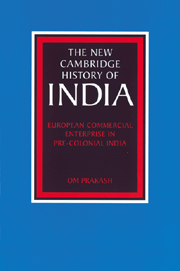Book contents
- Frontmatter
- Dedication
- Contents
- List of figures
- List of maps
- List of tables
- General editor's preface
- Preface
- Introduction
- 1 India in the Indian Ocean trade, circa 1500
- 2 The Portuguese in India, 1500–1640
- 3 The European trading companies: exports from Europe and the generation of purchasing power in Asia
- 4 The companies in India: the politics and the economics of trade
- 5 Euro-Asian and intra-Asian trade: the phase of Dutch domination, 1600–1680
- 6 The VOC and the growing competition by the English and the French, 1680–1740
- 7 The supremacy of the English East India Company, 1740–1800
- 8 European trade and the Indian economy
- 9 Conclusion
- Bibliographic Essay
- Index
- Misc-endmatter
- Map 1 Important trading centres in Asia in the seventeenth and eighteenth centuries"
- Map 2 Portuguese seaborne empire, c. 1580"
- Map 3 The Indian Ocean in the seventeenth and eighteenth centuries, showing the settlements of the English East India Company and of other European nations"
- Map 4 India: main textile–weaving areas, 1600–1750"
- References
4 - The companies in India: the politics and the economics of trade
Published online by Cambridge University Press: 28 March 2008
- Frontmatter
- Dedication
- Contents
- List of figures
- List of maps
- List of tables
- General editor's preface
- Preface
- Introduction
- 1 India in the Indian Ocean trade, circa 1500
- 2 The Portuguese in India, 1500–1640
- 3 The European trading companies: exports from Europe and the generation of purchasing power in Asia
- 4 The companies in India: the politics and the economics of trade
- 5 Euro-Asian and intra-Asian trade: the phase of Dutch domination, 1600–1680
- 6 The VOC and the growing competition by the English and the French, 1680–1740
- 7 The supremacy of the English East India Company, 1740–1800
- 8 European trade and the Indian economy
- 9 Conclusion
- Bibliographic Essay
- Index
- Misc-endmatter
- Map 1 Important trading centres in Asia in the seventeenth and eighteenth centuries"
- Map 2 Portuguese seaborne empire, c. 1580"
- Map 3 The Indian Ocean in the seventeenth and eighteenth centuries, showing the settlements of the English East India Company and of other European nations"
- Map 4 India: main textile–weaving areas, 1600–1750"
- References
Summary
The history of the European companies' trading operations in India over the seventeenth and eighteenth centuries in the context of their overall trade in Asia can be broadly divided into three fairly distinct phases with the cut-off points lying approximately around 1680 and 1740. In the case of the Dutch East India Company, the phase until about 1680 was basically one where the importance of the Indian trade was derived chiefly from its role in the Company's intra-Asian trade. Textiles from Coromandel and Gujarat were indispensable for the procurement of pepper and other spices, while raw silk from Bengal had become the mainstay of the bullion-supplying Japan trade. In the period after about 1680, the drastically altered composition of the imports into Europe, with a dominant role for Indian textiles and raw silk, ensured a continuing critical role for India, though it was now basically in the Company's Euro-Asian trade. This phase lasted until about 1740, when the dominant role of India was challenged to a certain extent by Chinese tea, which now accounted for around one third of the total imports from Asia, though later this figure came down to about a quarter.
Basically the same time division is applicable in the case of the English East India Company. Also, the English Company's emergence as a political power in the subcontinent in the latter half of the eighteenth century puts this period into a category by itself. The newly acquired power of the English had a variety of consequences.
Keywords
- Type
- Chapter
- Information
- European Commercial Enterprise in Pre-Colonial India , pp. 111 - 174Publisher: Cambridge University PressPrint publication year: 1998

